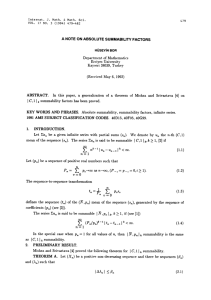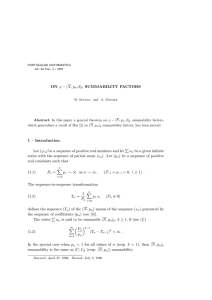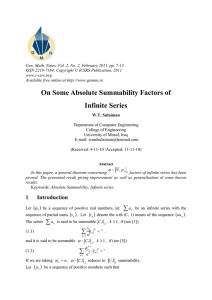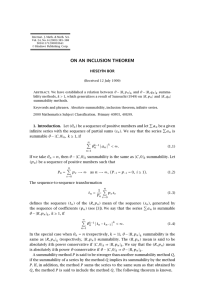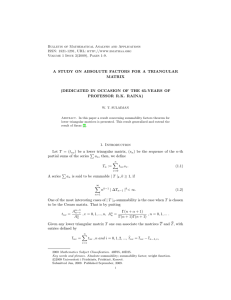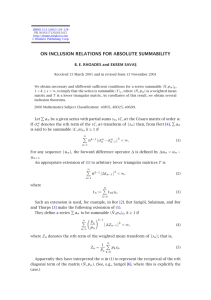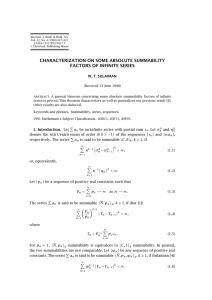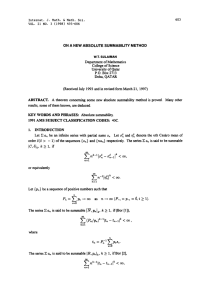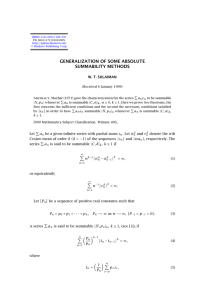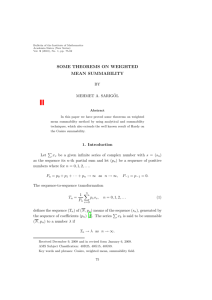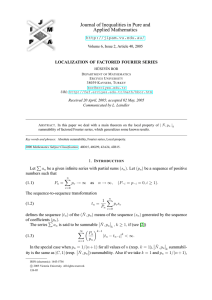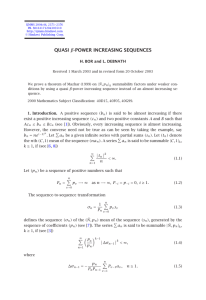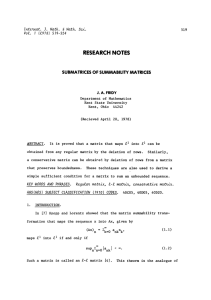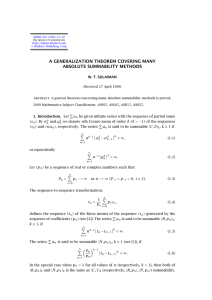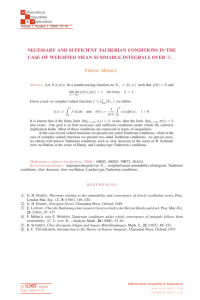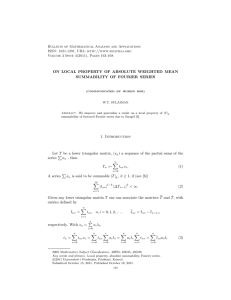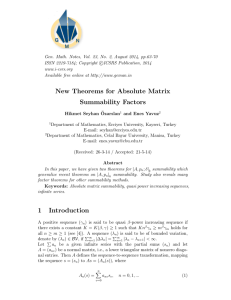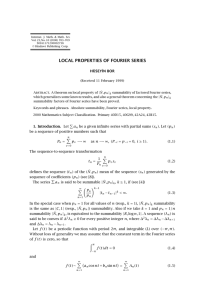A SUMMABILITY FACTOR THEOREM FOR ABSOLUTE SUMMABILITY INVOLVING ALMOST INCREASING SEQUENCES
advertisement
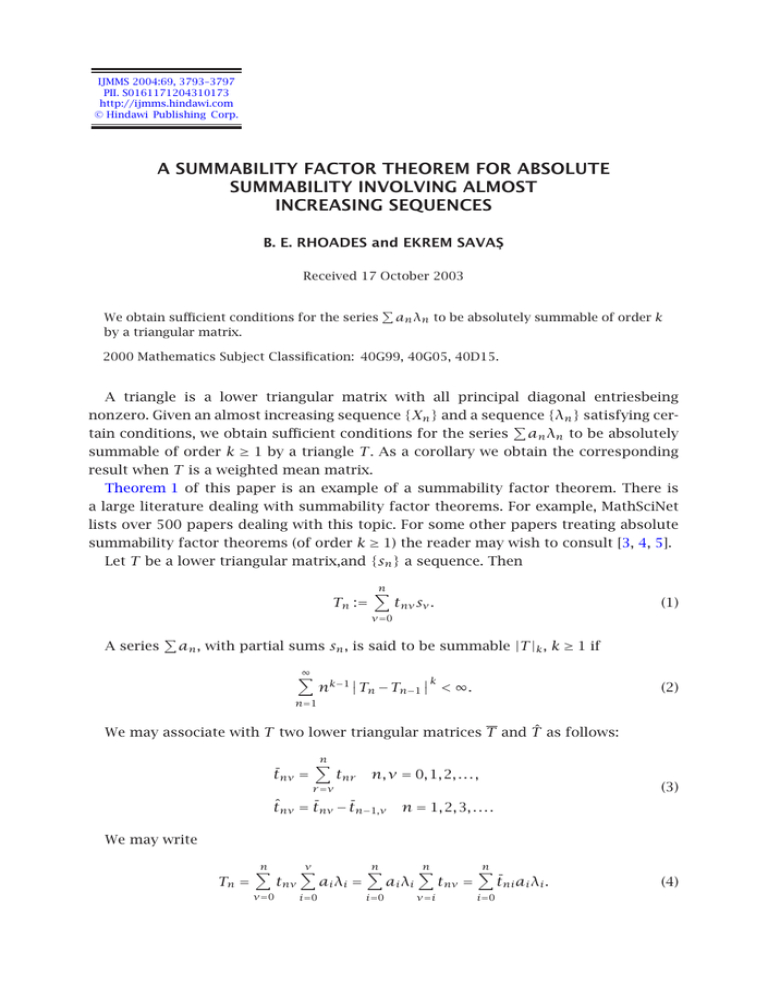
IJMMS 2004:69, 3793–3797
PII. S0161171204310173
http://ijmms.hindawi.com
© Hindawi Publishing Corp.
A SUMMABILITY FACTOR THEOREM FOR ABSOLUTE
SUMMABILITY INVOLVING ALMOST
INCREASING SEQUENCES
B. E. RHOADES and EKREM SAVAŞ
Received 17 October 2003
We obtain sufficient conditions for the series
by a triangular matrix.
an λn to be absolutely summable of order k
2000 Mathematics Subject Classification: 40G99, 40G05, 40D15.
A triangle is a lower triangular matrix with all principal diagonal entriesbeing
nonzero. Given an almost increasing sequence {Xn } and a sequence {λn } satisfying cer
tain conditions, we obtain sufficient conditions for the series an λn to be absolutely
summable of order k ≥ 1 by a triangle T . As a corollary we obtain the corresponding
result when T is a weighted mean matrix.
Theorem 1 of this paper is an example of a summability factor theorem. There is
a large literature dealing with summability factor theorems. For example, MathSciNet
lists over 500 papers dealing with this topic. For some other papers treating absolute
summability factor theorems (of order k ≥ 1) the reader may wish to consult [3, 4, 5].
Let T be a lower triangular matrix,and {sn } a sequence. Then
Tn :=
n
tnν sν .
(1)
ν=0
A series
an , with partial sums sn , is said to be summable |T |k , k ≥ 1 if
∞
k
nk−1 Tn − Tn−1 < ∞.
(2)
n=1
We may associate with T two lower triangular matrices T and T̂ as follows:
t̄nν =
n
r =ν
tnr
n, ν = 0, 1, 2, . . . ,
t̂nν = t̄nν − t̄n−1,ν
(3)
n = 1, 2, 3, . . . .
We may write
Tn =
n
ν=0
tnν
ν
i=0
ai λi =
n
i=0
ai λi
n
ν=i
tnν =
n
i=0
t̄ni ai λi .
(4)
3794
B. E. RHOADES AND E. SAVAŞ
Thus
Tn − Tn−1 =
n
t̄ni ai λi −
n−1
i=0
=
n
n
t̄ni ai λi −
i=0
=
t̄n−1,i ai λi
i=0
t̄n−1,i ai λi
i=0
n
t̄ni − t̄n−1,i ai λi
i=0
=
=
n
t̂ni ai λi =
i=0
i=0
n−1
n
i=0
=
n
n−1
t̂ni λi si −
t̂ni λi si − si−1
(5)
t̂ni λi si−1
i=0
t̂ni λi si + t̂nn λn sn −
i=0
=
n−1
t̂ni λi si−1
i=0
t̂ni λi si + tnn λn sn −
i=0
=
n
n−1
t̂n,i+1 λi+1 si
i=0
n
t̂ni λi − t̂n,i+1 λi+1 si + tnn λn sn .
i=0
We may write
t̂ni λi − t̂n,i+1 λi+1 = t̂ni λi − t̂n,i+1 λi+1 − tn,i+1 λi + tn,i+1 λi
= t̂ni − t̂n,i+1 λi + tn,i+1 λi − λi+1
(6)
= λi ∆i t̂ni + t̂n,i+1 ∆λi .
Therefore
Tn − Tn−1 =
n−1
i=0
∆i t̂ni λi si +
n−1
i=0
t̂n,i+1 ∆λi si + tnn λn sn
(7)
= Tn1 + Tn2 + Tn3 .
A positive sequence {bn } is said to be almost increasing if there exists a positive
increasing sequence {cn } and two positive constants A and B such that Acn ≤ bn ≤ Bcn
for each n.
Theorem 1. Let {Xn } be an almost increasing sequence and let {βn } and {λn } be
sequences such that
(i) |∆λn | ≤ βn ,
(ii) lim βn = 0,
∞
(iii)
n=1 n|∆βn |Xn < ∞,
(iv) |λn |Xn = O(1)
are satisfied.
3795
SUMMABILITY FACTOR THEOREM
Let T be a triangle satisfying the following:
(v) ntnn = O(1),
(vi) tn−1,ν ≥ tnν for n ≥ ν + 1,
(vii) t̄n0 = 1 for all n,
m
(viii) if n=1 (1/n)|sn |k = O(Xm ), then the series an λn is summable |T |k , k ≥ 1.
Proof. To prove the theorem it will be sufficient to show that
∞
k
nk−1 Tnr < ∞ for r = 1, 2, 3.
(8)
n=1
From [2, page 86] it follows that (vi) and (vii) imply that
n−1
∆i t̂ni = O tnn .
(9)
i=0
From (iv) and the fact that {Xn } is almost increasing, it follows that λn = O(1). Using
Hölder’s inequality, (9), and (v),
m+1
k m+1
nk−1 Tn1 ≤
nk−1
n=1
n=1
≤
m+1
n−1
k
∆i t̂ni λi si i=0
n−1
n−1
k−1
∆i t̂ni λi k si k
∆i t̂ni nk−1
n=1
i=0
= O(1)
m+1
i=0
k−1 n−1
∆i t̂ni λi k si k
ntnn
n=1
= O(1)
m+1
i=0
k−1 n−1
∆i t̂ni λi λi k−1 si k
ntnn
n=1
i=0
m
k m+1
k−1 λ i s i ∆i t̂ni ntnn
= O(1)
i=0
(10)
n=i+1
m
k
λi si tii
= O(1)
i=0
i
m
i−1
k
k
= O(1)
λi
s r tr r −
s r tr r
i=0
= O(1)
m
λ i i=0
r =0
r =0
i
m−1
k
s r t r r −
r =0
j=0
j
k
λj+1 sr tr r
r =0
m−1
i
m
k
k
s r t r r + λ m s r t r r .
= O(1)
∆λi r =0
i=0
r =0
If we define
Xi =
i
k
s r t r r ,
r =0
(11)
3796
B. E. RHOADES AND E. SAVAŞ
then {Xi } is an almost increasing sequence. Using (iv) and (i),
m+1
m−1
k
nk−1 Tn1 = O(1)
βi Xi + O(1) = O(1),
n=1
i=0
(12)
using the result of [1, Lemma 3].
Using (i), Hölder’s inequality, (ii), (v), (vi), and (vii),
m+1
n=1
n−1
k
k m+1
t̂n,i+1 si ∆λi nk−1 Tn2 ≤
nk−1 n=1
≤
m+1
i=0
n−1
k
k−1
n
t̂n,i+1 ∆λi si
n=1
≤
m+1
i=0
n−1
k
k−1
n
t̂n,i+1 si βi
n=1
≤
m+1
i=0
nk−1
n−1
n=1
t̂n,i+1 si k βi
n−1
k−1
t̂n,i+1 βi
i=0
= O(1)
m+1
i=0
k−1
ntnn
n=1
= O(1)
m
n−1
t̂n,i+1 si k βi
i=0
k
βi si i=1
m+1
t̂n,i+1 n=i+1
m
m
k
1 k
βi si = O(1)
iβi si = O(1)
i
i=1
i=1
= O(1)
m
βi
r =1
i=1
= O(1)
m
i=1
= O(1)
m−1
i=1
= O(1)
m−1
i s r k
iβi
r
k sr −
r
r =1
i−1
j i sr k m−1
sr k
−
(j + 1)βj+1
r
r
r =1
r =1
j=1
m
i
1
1
sr k + O(1)mβm
s i k
∆ iβi
r
i
r =1
i=0
∆ iβi Xi + O(1)mβm Xm
i=1
= O(1)
m−1
i=0
again using [1, Lemma 3].
m−1
i∆ βi Xi + O(1)
βi Xi + O(1)mβm Xm = O(1),
i=0
(13)
SUMMABILITY FACTOR THEOREM
3797
Using (v),
m+1
k m+1
k
nk−1 Tn3 ≤
nk−1 tnn λn sn n=1
n=1
= O(1)
m
k k
k−1
tnn λn sn ntnn
(14)
n=1
= O(1)
m
k−1 k
tnn λn λn sn = O(1),
n=1
as in the proof of Tn1 .
A weighted mean matrix, denoted by (N, pn ), is a lower triangular matrix with nonzero entries pk /Pn , where {pn } is a nonnegative sequence with p0 > 0 and Pn :=
n
i=0 pi → ∞ as n → ∞.
Corollary 2. Let {Xn } be an almost increasing sequence and let condition (viii) of
Theorem 1 be satisfied. If {βn } and {λn } satisfy conditions (i)–(iv) of Theorem 1 and if
{pn } is a sequence such that
(i) npn /Pn = O(1),
then the series an λn is summable |N, pn |k , k ≥ 1.
Proof. With T = (N, pn ), condition (v) of Theorem 1 reduces to condition (i). Conditions (vi) and (vii) of Theorem 1 are automatically satisfied.
It should be noted that, in [1], an incorrect definition of absolute summability was
used (see, e.g., [2]). Corollary 2 gives the correct version of Bor’s theorem.
Acknowledgment. This research was completed while the second author was a
Fulbright scholar at Indiana University during the fall semester of 2003.
References
[1]
[2]
[3]
[4]
[5]
H. Bor, An application of almost increasing sequences, Int. J. Math. Math. Sci. 23 (2000),
no. 12, 859–863.
B. E. Rhoades, Inclusion theorems for absolute matrix summability methods, J. Math. Anal.
Appl. 238 (1999), no. 1, 82–90.
B. E. Rhoades and E. Savaş, Some necessary conditions for absolute matrix summability factors, Indian J. Pure Appl. Math. 33 (2002), no. 7, 1003–1009.
, Some summability factor theorems for absolute summability, Analysis (Munich) 22
(2002), no. 2, 163–174.
, A summability type factor theorem, Tamkang J. Math. 34 (2003), no. 4, 395–401.
B. E. Rhoades: Department of Mathematics, Indiana University, Bloomington, IN 47405-7106,
USA
E-mail address: rhoades@indiana.edu
Ekrem Savaş: Department of Mathematics, Yüzüncü Yil University, 65080 Van, Turkey
E-mail address: ekremsavas@yahoo.com

